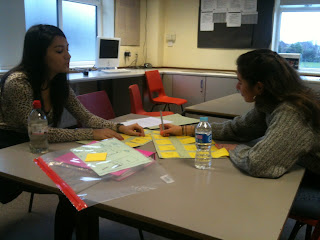Todorov's Theory
Todorov’s theory recognises the usual pattern for a
storyline. This can often be applied to the vast majority of films.
One film which clearly complies with Todorov’s theory is “Singin’
in the Rain” (1952)
The beginning equilibrium is that the main character, Don
Lockwood, is a silent movie star who can just tolerate his co-star, Lina
Lamont, and they pretend, for publicity to be romantically involved. Their
films are very successful, and are both very famous actors.
The disruption of the film is that “The Jazz Singer”, a film
with sound, has been very successful so all film companies are now using sound
in their movies.
The recognition is that there is success from sound films,
so there is no option but to turn the next Lockwood and Lamont film into a “talkie”.
The problem is that Lina’s voice is not seen as suitable for the sound.
The repair for the disruption is for Kathy, Don’s love
interest to talk over Lina’s acting, so it sounds like Lina’s voice. However,
the audience’s find out that it is Kathy’s voice not Lina’s and she is “the
real star of the film”.
The new equilibrium is Don and Kathy to star in their sound
film together, “Singin’ in the Rain”.
Another recognises theory is Levi Strauss’ theory, of there
being binary opposition. This is clearly visible in Titanic (1997).
Some opposition are:
Rich vs. Poor: Rose’s family expect her to marry into her
own class, not someone who is of a lower class.
Male vs. Female: There are clearly to main characters, and
Rose is supposed to act like a typical “woman” of that era.
Good vs. Bad: Jack is a good man, and Rose’s true love,
which is against Cal, who is a conman who does not want to be humiliated.
He outlined the different roles in films, which is obvious
in the film Bridesmaids (2011):
Hero= Annie
Villian= Helen
The Princess/Prize= Lillian, her best friend
The Donor= Rhodes
The Dispatcher= Helen
The Mentor= Annie’s mother
Bridesmaids also relates to Propp’s theory of narrative.
Preparation: Annie lives in Wisconsin, near to her best
friend. She has a job and lives with two room mates.
 Complication: Lillian is getting married and moving away.
Helen, is Lillian’s good friend who makes Annie feel threatened. Annie meets a
police officer, Rhodes, who she explains her troubles to.
Complication: Lillian is getting married and moving away.
Helen, is Lillian’s good friend who makes Annie feel threatened. Annie meets a
police officer, Rhodes, who she explains her troubles to.
Transference: Annie is given the chance to be maid of honour
and on several occasions, ruins the plans for the wedding preparations.
Struggle: Lillian and Annie are now barely talking, she is
forced to move in with her mother, who is helping her life get back on track, after losing her job. Annie is no longer
speaking to Rhodes who had become her love interest, and on the day of the
wedding Helen tells Annie that Lillian has gone missing.
Recognition: Rhodes helps Annie find Lillian. Lillian and Annie make up and Lillian gets married. Rhodes and Annie then make up and she is now happy to have her best friend back.

.jpg)








.jpg)






